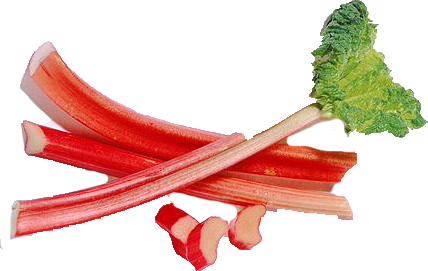|
Rhubarb is one of
the least calories vegetable. 100 g fresh petioles provide just 21 calories.
Nonetheless, it contains some vital phyto-nutrients such as dietary fibre, poly-phenolic
anti-oxidants, minerals, and vitamins. Further, its petioles contain no
saturated fats or cholesterol.
The stalks are
rich in several B-complex vitamins such as folates, riboflavin, niacin, vitamin
B-6 (pyridoxine), thiamin, and pantothenic acid.
Red colour stalks
contain more vitamin-A than green varieties. Further, the stalks also contain
small amounts of poly-phenolic flavonoid compounds like ß-carotene, zeaxanthin,
and lutein. These compounds convert to vitamin A inside the body and deliver same
protective effects of vitamin A on the body. Vitamin A is a powerful natural
anti-oxidant and is required by body for maintaining the integrity of skin and
mucus membranes. It is also an essential vitamin for vision. Research studies
suggest that natural foods rich in vitamin A helps body protect against lung
and oral cavity cancers.
Like in other greens like kale, spinach; rhubarb stalks also provide good
amounts of vitamin-K; 100 g of fresh stalks provide 29.3 µg or about 24% of
daily recommended intake. Vitamin K has potential role in bone health by
promoting osteotrophic (bone formation and strengthening) activity. Adequate
vitamin-K levels in the diet helps limiting neuronal damage in the brain; thus,
has established role in the treatment of Alzheimer's disease.
Its stalks also
contain healthy levels of minerals like iron, copper, calcium, potassium, and
phosphorus. However, most of them do not absorbed into the body as they subject
to chelating by oxalic acid into insoluble complexes and excreted out from the
body.
Weight Loss: Rhubarb is one of the lowest caloric vegetables on the market,
and as such, it is often recommended for people who are struggling to lose
weight, but still want to remain healthy. 100 grams of rhubarb contains only 21
calories, so feel free to load up on the rhubarb without packing on any pounds.
The impact that the various organic compounds in rhubarb have on the body’s
metabolism can also dramatically increase the rate that the body burns fat,
thereby helping you lose weight in another way!
Cardiovascular
Diseases: Rhubarb is extremely low in fat and
cholesterol, the vegetable poses no threat to cardiovascular health, and it can
actually increase the levels of good cholesterol due to the presence of dietary
fibre, which is known to scrape excess cholesterol from the walls of blood
vessels and arteries. Furthermore, the impressive amount of antioxidants in
rhubarb ensure that free radicals don’t cause heart disease and a wide range of
other dangerous health conditions.
Digestion: Our digestive system plays a huge part in our overall health, so
it is important to keep the digestive system healthy and regulated. The high
amount of dietary fibre found in rhubarb can help guaranteed a healthy
digestive system by bulking up stool and making sure that bowel movements are
smooth and regular. Rhubarb has traditionally been used as a cure for
constipation, but it was only recently discovered why it had such a powerful
effect. By easing constipation and other digestive issues, you can prevent a
wide range of more serious gastrointestinal disorders, including bloating,
cramping, and even colorectal cancer.
Alzheimer’s disease:
The most prominent vitamin in rhubarb is actually vitamin K, and
while it doesn’t often get as much attention as some of the other vitamins,
Vitamin K plays a very significant role in brain and neuronal health. It can
prevent the oxidation of brain cells and stimulates cognitive activity, thereby
helping to delay or even prevent the onset of Alzheimer’s disease.
Bone Health: Along with its role in protecting the brain from neural
degeneration, vitamin K also promotes osteotrophic activity, meaning that it
stimulates bone growth and repair. Combined with the rich amount of calcium and
other minerals found in rhubarb, the vegetable as a whole is a major player in
bone protection.
Cancer Prevention: Antioxidants have been widely studied in recent years due to
their ability to neutralize free radicals throughout the body. Free radicals
are by-products of cellular metabolism that can cause healthy cells to mutate
or die, often resulting in cancer or other chronic diseases. Rhubarb is a good
source of beta carotene and other polyphenolic compounds like lutein and
zeaxanthin which act in a similar way to vitamin A, protecting the skin and
eyes from the effects of free radicals. A decent amount of antioxidants in your
diet can help delay premature aging, cataracts, macular degeneration, and
wrinkles. Furthermore, these polyphenolic compounds have been connected to
preventing oral and lung cancers!
Blood Circulation: The trace amounts of copper and iron found in rhubarb are enough
to stimulate the production of new red blood cells, increasing the total RBC
count in the body and increasing oxygenation of essential areas of the body,
thereby improving their function and boosting the overall metabolism of the
body.
A Few Words of Warning: Due to the potent nature of rhubarb, you should avoid it if you
have a pre-existing kidney condition or certain gastrointestinal conditions, as
it can make them worse. Also, be careful that children or pets do not eat the
rhubarb leaves if you grow the plant yourself. There have been some cases of
death due to the toxic levels of oxalic acid contained in the leaves. Other
than that, rhubarb is a delicious and beneficial food for you and your family
to enjoy!
|

